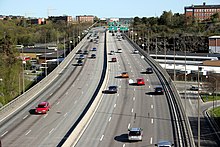Motorway (Sweden)


The motorway in Sweden is called Motorväg (plural Motorvägar ) and is a road connection with motorway standard . In contrast to many other countries, Sweden does not have an independent motorway network or a separate numbering of its Motorvägar , but these can be parts of the Länsvägar (provincial roads) or Riksvägar (imperial roads). The marking and signage on the Swedish motorways (white sign on a green background) corresponds to the Vienna Convention on Road Signs of 1968.
Compared to Germany and Italy , motorways were introduced quite late in Sweden. Interest arose in the late 1940s and the first motorway-like road was built between Gothenburg and Alingsås during the 1940s . This road did not quite meet the motorway standard, but already had separate lanes with no oncoming traffic. The first official Motorväg with motorway standard was laid out, based on the German model, with a concrete lane between Malmö and Lund and inaugurated in 1953 by Prince Bertil of Sweden . The section was 17 km long.
The expansion of the Swedish Motorvägar has been slow compared to other countries and has mainly focused on connecting the three metropolitan areas of Stockholm , Gothenburg and Malmö . Even today, the Stockholm - Helsingborg / Malmö connection is missing a small section of 32 km near Ljungby , which has the character of a road .
Further facts:
- According to the Trafikverket, the length of the Swedish motorway network is 2050 km (2015).
- The most heavily used Motorväg section is the Essingeleden in Stockholm with an average of 150,000 vehicles per day and direction.
- The longest motorway tunnel in Sweden is the Södra-Länken tunnel in Stockholm with a length of over 6 km.
- A general maximum speed ( hastighetsgräns ) of 110 km / h applies on Sweden's Motorvägar, and 120 km / h has been permitted on certain sections of the route since autumn 2008.

